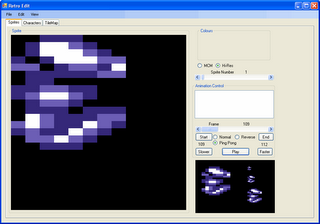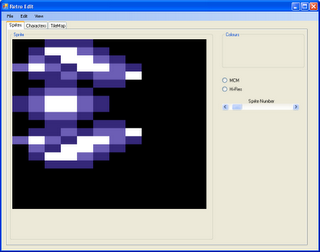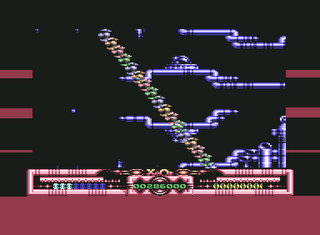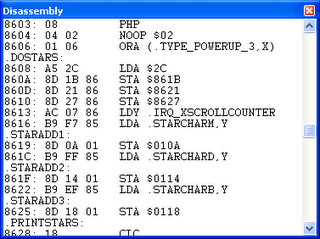Thursday, October 12, 2006
XeO3: Play the game....
Or should we do a normal game and let it get hacked live every other game does?
Wednesday, October 11, 2006
XeO3: And then there were 3.....
So, after that great news....I've nothing much to report. I've had an evening off and sat down and watched a film. I have imported the Plus/4 colour map into the editor and tomorrow I hope to start making the editor more usable - rather than just an animation tool. Still I'm a little sort on energy, so I think its an early night.
So...nothing done and it's STILL been a great night for XeO3 news!!
Tuesday, October 10, 2006
XeO3: Retro Edit

After talking to Luca, I feel somewhat ashamed. He described the process he uses for creating sprites and it was so bad, I was virtually blushing. I am now even more amazed at the superb animations he's manahed to create despite the terrible tools he's using. So, I've vowed to correct this as fast as I can. To this end, I've changed the focus of the editor, it really will now become a Jack of all trades. I'll do +4 sprite editing first, then add C64 editing so that I can get those streachy sprites, and then onto character and tile map editing and so on.
However,m before anyof that, I need to get Luca some tools he not only could use, but really wants to use. The problem with any developer is that we get so used to using our old tools that we just don't want to change, so I need to give him a tool that feels like his old slippers, buthas a whole new set of features that empower him.
The first on the list was loading in the current sprites and then being able to play back certain animations in various modes. This is now done. He can now scroll through the whole set, pick start and end frames, then play them back forward, backwards and in "pingpong" mode (where it bounces back and forth). This should at least allow him easier viewing until I can actually get editing and saving in place.
In the future, I think a realtime linkup with an actual machine would be very cool, as the anim plays on the PC, it also plays on your Plus/4 or C64 on the Tv... also theres no reason why when you plot a pixel on the PC you dont SEE that on the actual machine as well. I wonder how many people would use that......
Monday, October 09, 2006
XeO3: Editor

I've managed to get the Plus/4 sprites up and visible which is fine - fairly easy in C#, so next I'll need to get them scaling. I'll probably change a couple of bits internally so that I can have either 12x21 or 8x16 MCM sprites, this will let me view/edit either C64 or Plus/4 objects.
I released a new version of my assembler yesterday as well, I don't think very many folk use it, but I find it's really handy - particually the macro support which lets you do quite a lot.Turns out though that I don't test it nearly enough! One of the chaps on Lemon64 has managed to crash it a couple of times with ease. I guess without testers this kind of this will happen. Anyway, if you want to play with it you can grab it from my minus4 site.
XeO3: Editors.
Once I have the drawing working, I'll write a quite scale function that'll allow me to save out full size C64 sprites - although they'll be a bit rough around the edges. The biggest issue I have with XeO3 on the Plus/4, is that I can't view or edit sprites easily, Luca has to make little Plus/4 programs that show his work animating in a self contained PRG, which is far from ideal - so I hope this will help a bit more.
Level editing is also a concern as the current one was created by "FatMan", and he has long since vanished. So now we really need to be able to create one outselves, particually if we want others to make new levels or even games out of it.
I'll have to watchout when doing this program, as the temptation is to make an all singing all dancing app, which will take longer to write than the game itself. If I was doing an editor to "sell", I guess I would make everything variable and portable. But the idea is to keep the goal in mind, and not get too carried away with what should remain, a simple XeO3 editor.
Sunday, October 08, 2006
XeO3: C#
On another note, I was speaking to TNT over at Lemon64 and we got into chatting about old programming diarys from ZZap days, anyway he reminded me about the Citadel one as well as the Morpheus one I've just read. I seem to remember this one being pretty cool to. He's currently doing a supped up version of Paradroid and I'm trying to persuade him to do a diary as well. I love reading techy stuff like this, and I'm sure others do to. These days games are such a closely guarded secret that you never get to hear the gritty details which is a shape. Also things are now so complicated that it can take weeks to do the smallest thing which doesn't make for good reading.
If you have an opinion on this, or if you like reading this kind of stuff, then let me know and perhaps I'll start to try and push more people to keep retro coding blogs.
Saturday, October 07, 2006
XeO3: A job well done....
;
; \0 = sprite number ( 1,2,3,4,5,6,7 )
; \1 = x+y offset ( 2,4,6,8,10,12,14 )
; \2 = NEXT sprite ( 2,3,4,5,6,7,1 )
; \3 = "b" for bcc or "j" for jcc
;
sub_amount equ 10 ; number of lines before a sprite needs to be setup
SetUpSprite macro
DoSprite\0:
cpy #\0 ; is this the Hardware sprite we're after?
bne NextHWSprite\0 ; not THIS sprite ->jump to next
SkipCPY\0:
lda XTable,x ; Store the sprites "X" coordinate in the
sta $d000+\1 ; VIC hardware sprite register
lda $d010 ; get all sprite significant bits
and #~(1<<\0) ; mask OFF this one
ora XSig,x ; already set for the correct bit!
sta $d010 ; so we OR in this sprite and store it!
lda YTable,x ; Get sprite Y coordinate
sta $d001+\1 ; store in VIC hardware register
lda XShape,x ; get the sprite graphic
sta HWShape1+\0 ; Since we have a double buffered screen,
sta HWShape2+\0 ; we store it in BOTH locations.
lda SprCol,x ; Get sprite colour
sta $d027+\0 ; store in VIC hardware
inx ; next sprite in list
ldy #\2 ; next hardware sprite
lda YTable,x ; Get sprite Y
jeq EndOfSpriteList2 ; 0? If so all finished
sbc $d012
cmp #4 ; do we HAVE enough time for another IRQ? (magic number)
\3cc SkipCPY\2 ; if not do it now!
;
; If we've lots of raster time until the next sprite
; but the sprite we will be copying over was already drawn
; by the VIC, then just copy it over NOW!
;
;sec ; Carry is ALREADY set
lda $d012 ; Get the current raster
sbc #22 ; -22 gets us the last "safe" sprite
sbc $d001+(\2*2) ; location. Now subtract the next sprite Y
\3cs SkipCPY\2 ; is > last sprite, then setup NOW!
;
; If its further down the screen, and the current sprite
; is still being drawn, then setup a new IRQ just above the
; sprite to handle it
;
;sec ; dont set carry, we'll offset this in the SBC
lda YTable,x ; if we can't copy now, then we set up
sbc #sub_amount-1 ; a new RASTER IRQ based on the next sprite (-1 for SEC)
sta $D012 ; and its Y coord.
jmp EndMultiIRQ ; and then this starts all over again!
NextHWSprite\0:
endm
I may not have mentioned this to the C64 guys, but once the game is finished, I plan on giving the source out, along with some documentaion that should allow others to either skin it quickly into another shooter, or to hack it into something completely different. I've always thought that the main problem with the scene was that good games take time, so no one can usually be bothered to make one - and when they do, they feel completely attached to the source and want to keep their master-peice. So I decieded from Day 1 of the Plus4 version that it was all going to get released. There no money in it, so why hold on to it when it could do so much good the scene.
That supercpu shoot-em-up is a good example - I wonder how much they actually made from it.... whats the point? I'm even trying to keep the comments up to date!! So don't say I'm not good to you all!!
Also, if theres anything I've touched on that anyone would liked explained, then just drop a comment letting me know, and I'll try to post something more about it.
XeO3: Multiplexor V1.0
 Well, the first version is done and although it still needs seriously optimised, it's in and working. I ended up using a slight hybrid between the one from Blood Money, and Dan's one from Armalyte. I loved the way he gathers sprites into blocks IF the hardware sprite your going to overwrite next has finished rendering, then it doesn't bother with a new IRQ, it just does it anyway! Very cool. I'll probably unroll the multiplexor IRQ and that'll help me get sprites closer to other ones. It looks like I'll have to redo a few paths from the Plus4 as they are a little close for the multiplexor (since they're 16x16 and not 24x21); theres an advantage to having software sprites... Still, it'll probably make the games a little different so you can have fun playing them both!
Well, the first version is done and although it still needs seriously optimised, it's in and working. I ended up using a slight hybrid between the one from Blood Money, and Dan's one from Armalyte. I loved the way he gathers sprites into blocks IF the hardware sprite your going to overwrite next has finished rendering, then it doesn't bother with a new IRQ, it just does it anyway! Very cool. I'll probably unroll the multiplexor IRQ and that'll help me get sprites closer to other ones. It looks like I'll have to redo a few paths from the Plus4 as they are a little close for the multiplexor (since they're 16x16 and not 24x21); theres an advantage to having software sprites... Still, it'll probably make the games a little different so you can have fun playing them both!I'll probably try and get a C64 teaser done soon now, but I still have a couple of bugs to fix on it - and the sprites are still all actually only 16x16, even though its displaying 24x21! I might just "scale" them for now, just so they fill more of the screen.
Luca has also said he's not really interested in doing any changes for the C64 version - he's a Plus/4 man through and through, so nearer the time I'll be on the look out for a dedicated C64 artist to add some spit and polish.
Friday, October 06, 2006
Xeo3: Vice...

Well, thanks to the comment made the other day, I've managed to add symbols to VICE. Since I use my own assembler, it was a quick 10 min job to get the symbol table exported in the VICE format. This does help when trying to track down odd bugs so its very much appricated - whoever it was (names on the comments would help!). Although not being able to have a memory window is prehistoric!!
I've got the basic flow of the Multiplexor in, so now I need to test the start of it, and then start generating interrupts. I can test the beginings since I copy in the first 7 sprites in the list to save having to do early interrupts. Its also a good way to start, it lets you see if things are progressing the way you expect.
Xeo3: Multiplexor...
So now that its all sorted, I'm just about to start on the actual fun stuff! Building new raster interrupts based on where a sprite needs to go. When I first used this in Blood Money (after hacking Armalyte to find out how he did it), I thought it was very cool indeed. In fact, it took me a while to actually believe thats what he was doing - very cool stuff. In Ballistix, I'd gone with a static array as documented by Braybrook in Morpheus, and since I HAD to control 32 sprites for that, it was probably a fairly wise course of action. But for Blood Money, I could use something more flexible, and after seeing Armalyte, I just had to know how he did it.
Anyway, I'm about to do it again. I'm not quite sure if I'll follow his IRQ routine either, as I hate maintaining large unrolled loops. Im sure at some point in the future I can unroll it if I need to.
OH! And I've just discovered a 4th C64 that I have, and its the older ones with the original SID chip in it, so I can at last listen to all the old classics on the machine itself! Ahh...bliss.